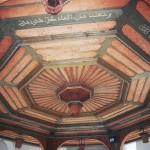Islamic Architecture: Gazi Husrev-beg Mosque in Sarajevo
This response was inspired by the Week 6 and Week 13 readings on the debate on Islamic art, and particularly the readings by M. Frishmann and H. Khan (The Mosque) M. Sells (“Erasing Culture: Wahhabism, Buddhism, Balkan Mosques”), and Nader Ardalan (“On Mosque Architecture”). Of particular interest to me was the “Begova Djamija” (formally known as the Gazi Husrev-beg Mosque) in Sarajevo, Bosnia and Herzegovina which was discussed in Sells’ article. Begova Djamija is often considered to be the most important Islamic structure in the country, and is the largest and most visited Islamic building in the Balkan region. However, as Michael Sells notes, its pre- and post- war construction are sometimes debated.
Located in the busiest neighborhood of Sarajevo, Begova Djamija was originally built by the Ottomans in 1531 and encompassed beautiful ornamentation and over 50 large windows that produced a great sense of light and space. The main architect and financier of the mosque, Gazi Husrev-beg, wrote in his memoirs: “I built the mosques, the bridges, the inns for travellers, and my vakuf is the finest that will ever be known. They will say, in the time to come, that Gazi Husref-beg turned Sarajevo village into Sarajevo town.” In the courtyard of the mosque is a sadrvan, or Islamic fountain. As is customary in Islamic tradition, the fountain is used to cleanse oneself before entering the mosque.
During the Bosnian War of 1992-1995, however, Begova Djamija had become a target for Serb artillery and shelling. As a result, it was heavily damaged and much of the exterior of the almost 500-year old mosque was destroyed. In 1996, however, it was renovated with foreign help—particularly from the Syrians and Saudi Arabs. Prominently, Sells has criticized the renovations as being “too influenced” by Wahhabism (Sells, 8). For example, before the reconstruction, most of the interior of the mosque was very intricate—with many complex colors and design schemes. With the new renovations, however, most of the walls have been maintained purely white, and much of the detail and color have been taken out from the interior.
While this debate has remained primarily within the scholarly realm and has not yet found much discussion within Bosnia’s social context, it is very important that such discussions remain active as Bosnia continues with much of its post-war reconstruction through the coming years. Bosnia is a particular place for Islam as it has experienced a very complicated, and sometimes turbulent, history of the religion and its peoples’ ascriptions to the faith. As most scholars would agree, Bosnia has experienced a certain type of renewal of the Islamic faith after years of Communist rule during which religion did not play a prominent role in the daily lives of Bosnians. Along with this, there has been a renewed interested in Islamic architecture in the area. But, as more mosques and other Islamic structures are built in Bosnia, it will remain critical that Bosnia, and Bosnians, retain and build their own “Islamic identity” through these endeavors. Through 2010, most of the financiers and architects of Bosnia’s Islamic buildings have been foreign—and while the financial help and architectural inspiration of other Islamic cultures are integral components of any architectural design, Bosnia’s post-war period should be seen as a time for Bosnian Muslims to recreate a post-war history and an Islamic revival of their own.






